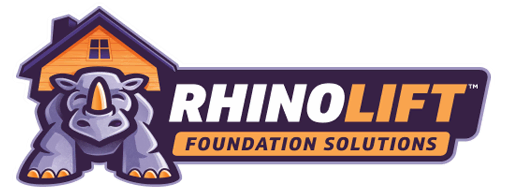Mudjacking is a Concrete Lifting technique that involves drilling small holes into the concrete slab and injecting a slurry of cement, water, and soil beneath the slab. The slurry fills any voids or gaps beneath the slab and raises it back to its original position.
WHEN MUDJACKING IS NEEDED
Mudjacking is commonly used to repair concrete surfaces such as driveways, sidewalks, patios, and garage floors that have settled or sunk due to soil erosion, poor compaction, or other factors. The process can also be used to level uneven concrete surfaces that pose tripping hazards.
How it’s done
Mudjacking typically involves the following steps:
- Inspection: A foundation repair contractor like RhinoLift Foundation Solutions inspects the concrete slab and identifies the areas that need to be raised or stabilized.
- Drilling: Small holes are drilled into the concrete slab at strategic locations to access the voids or gaps beneath it.
- Injection: A slurry of cement, water, and soil is injected through the drilled holes into the voids or gaps beneath the slab. The slurry fills the voids and raises the slab back to its original position.
- Patching: After the slab has been raised, the holes are patched with concrete or other material to match the surrounding surface.
Other Types of Concrete Lifting
The best method for concrete lifting depends on several factors, including the size and weight of the concrete slab, the severity of the settling or sinking, the condition of the surrounding soil, and the accessibility of the site. Here are a few of the most commonly used methods for concrete lifting:
- Polyurethane foam injection: This method involves injecting high-density polyurethane foam beneath the concrete slab through small holes. The foam expands and lifts the slab back to its original position while also filling any voids or gaps beneath the slab.
- Mudjacking: As explained earlier, this method involves injecting a slurry of cement, water, and soil beneath the concrete slab to fill any voids or gaps and raise it back to its original position.
- Slab piers: This method involves installing steel piers beneath the concrete slab and using hydraulic jacks to lift the slab back to its original position. The piers are then anchored in place to provide long-term stability.
- Helical piers: This method involves installing helical piers beneath the concrete slab to support and stabilize the foundation. The piers are screwed into the ground and then attached to the slab using steel brackets.
- Concrete replacement: In some cases, it may be necessary to replace the entire concrete slab if it is severely damaged or has settled beyond repair.
Each of these methods has its own advantages and disadvantages, and the best method for your specific situation will depend on several factors.
Synopsis
Mudjacking is a cost-effective and relatively quick method for repairing settled or sinking concrete slabs. However, it may not be suitable for all situations. In cases where the soil beneath the slab is unstable or there are significant structural issues with the foundation, other foundation repair methods such as underpinning may be necessary. It’s important to consult with RhinoLift Foundation Solutions Foundations to determine the best solution for your specific needs.
